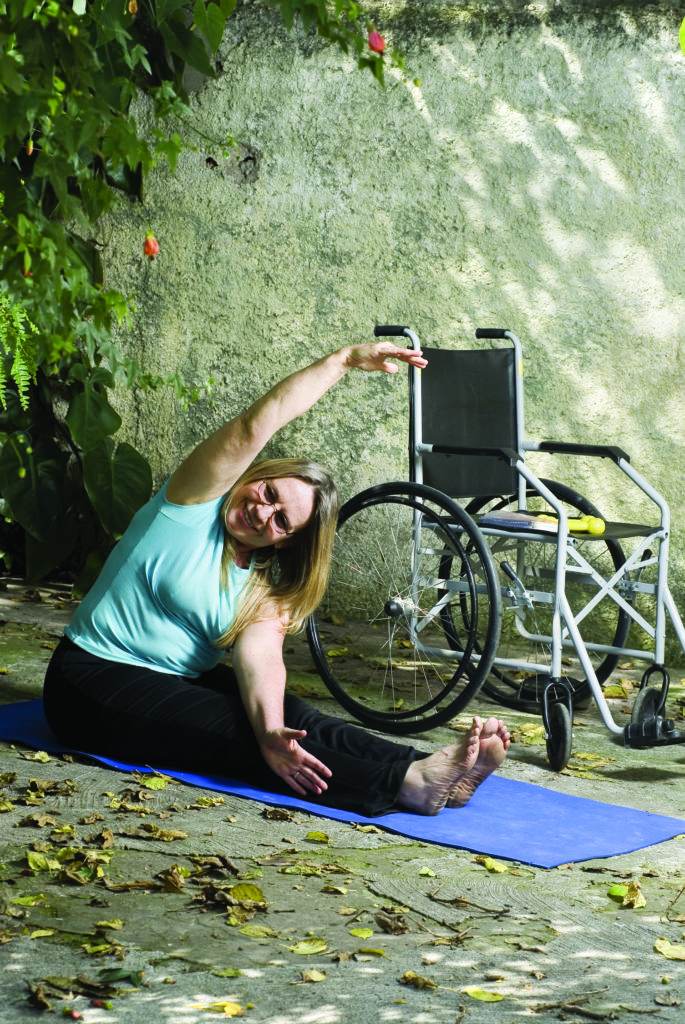Opening Doors to All
Abilities, Sizes, and Shapes
BY JACKIE BARSHAK
With the passage of the Americans with Disabilities Act of 1990, schools began implementing programs integrating disabled students with able-bodied students, allowing them to share the same activities, learning opportunities, and experiences both inside and outside the classroom. Inclusive education, regarded as a civil right, is based on evidence that students with disabilities learn and achieve more in collaborative settings with able-bodied students where their differences are respected.
By the time inclusion programs were being implemented in schools, inclusivity had already gained momentum in the yoga community. Yoga teachers had actively been seeking out diverse students and adapting their studios to accommodate disabled students, offering them modifications and adjustments. The movement to make yoga more accessible was spread by teachers who pulled into the center those who had been pushed to the margins—everyone was invited in. Welcoming of all abilities, disabilities, sizes, shapes, and backgrounds, yoga teachers embraced an adaptive style of yoga, making it safe and comfortable to practice.
Teachers adapted asanas according to both the needs of their students and their own knowledge of medical conditions. They designed a personalized practice, holding space for their students to release, transform, and heal. A movement grew, dedicated to sharing the benefits of yoga with communities that had been excluded or underserved. Today that movement is called “accessible yoga.” Its teachers are trained in a combination of modalities—supported restorative poses, gentle yoga, breathwork, guided meditation, yogic teachings, and hands-on healing. Teachers learn to be at ease with students with physical limitations and respond compassionately to their struggles. Instruction is student-centered. Teachers may demonstrate several variations of a pose based on the student’s disability and then defer to the student to choose which to practice. Teachers themselves may also be dealing with physical challenges and be limited to offering verbal instructions and their focused attention.

In addition to providing a healing practice for their disabled students, accessible yoga teachers also recognize the need to advocate for media representations of all body types practicing yoga. Mainstream media representations of wheelchair users practicing yoga sends the message that inclusion of people with all disabilities and body types is the just and equitable thing to do. The Yoga Body Image Coalition, a community partner of the educational and advocacy network Accessible Yoga, uses stereotypes as a starting point in its critique of systems of representation that pose barriers to the prospective practitioner.
Resolving to “be the media,” the body positive Yoga Body Image Coalition has taken down popular media with its awareness-raising campaigns #ThisIsWhatAYogaBodyLooksLike and #ThisIsWhoCanPracticeYoga. In its promotion of body-size-and-shape acceptance, the coalition challenges stereotypes seen in media representations of yoga. It holds the media accountable for marginalizing certain groups by excluding them from representation. Its critique of media images includes the idealized yoga practitioner, represented by a young, white, thin, conventionally attractive, hetero, able-bodied, and highly sexualized female. Representations of white women as sexualized marketing material in yoga advertisements reflect and reinforce other systems of oppression such as the ageism, ableism,
sizeism, heterosexism, classism, and racism seen in dominant culture. Accessible yoga, with its message of diversity and inclusion, presents an alternative.
Rather than leading the way for a yogic shift in consciousness, mainstream media has made minority yoga practitioners invisible, reducing diversity to the margins. Instead of mirroring white, able-bodied privilege, the media should be welcoming everyone back to wholeness, to peace. With its media literacy campaigns, the Yoga Body Image Coalition is promoting ways to take yoga back from corporate media.
Yoga holds gifts for all of us, regardless of our physical condition, size, or ability and can be made available to everyone. Find out more at the fourth Accessible Yoga Conference, taking place in San Francisco on October 6–8, 2017. AccessibleYoga.org
Jackie Barshak, MA, is an art historian, certified yoga teacher, Transcendental Meditation teacher, former host of “Women’s Magazine” on KPFA radio, and an activist in police accountability